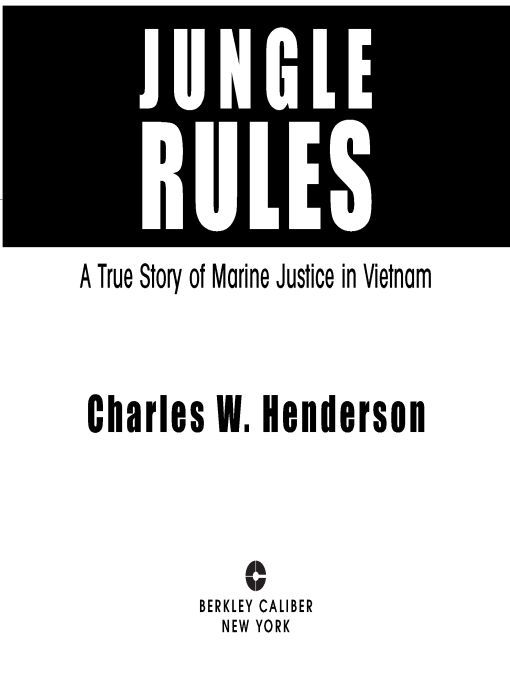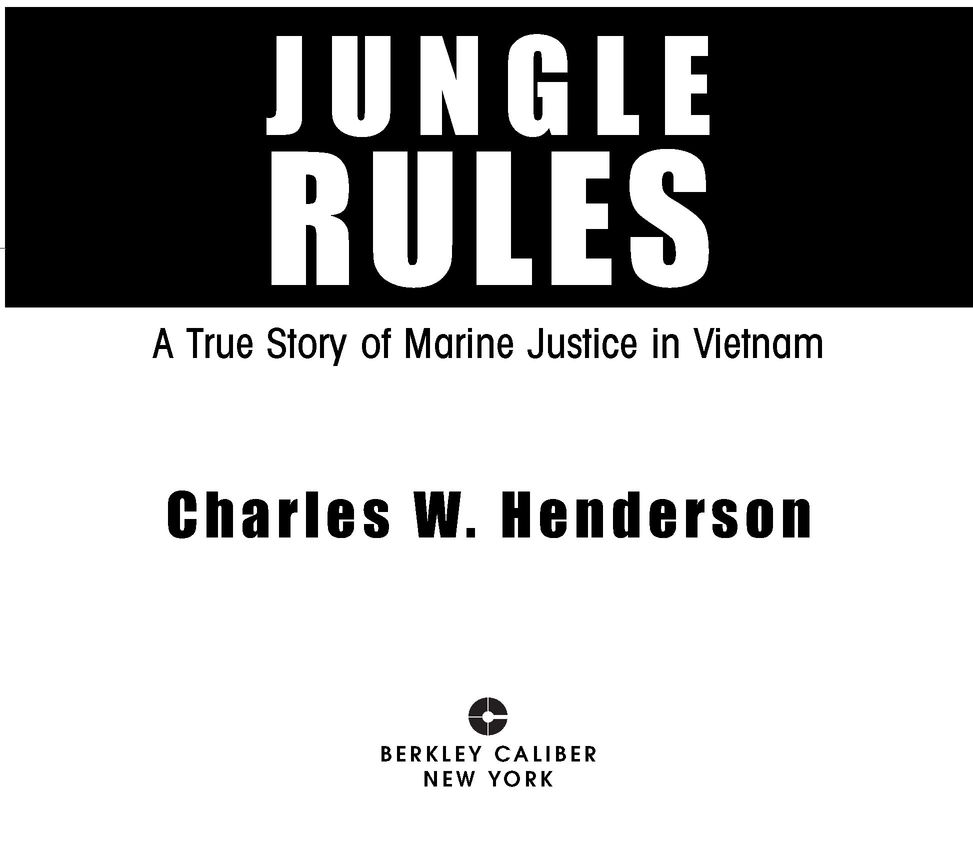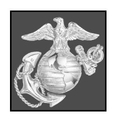Jungle Rules
Authors: Charles W. Henderson


Table of Contents
Most Berkley Caliber Books are available at special quantity discounts for bulk purchases for sales promotions, premiums, fund-raising, or educational use. Special books, or book excerpts, can also be created to fit specific needs.
For details, write: Special Markets, The Berkley Publishing Group, 375 Hudson Street, New York, New York 10014.

THE BERKLEY PUBLISHING GROUP
Published by the Penguin Group
Penguin Group (USA) Inc.
375 Hudson Street, New York, New York 10014, USA
Penguin Group (Canada), 90 Eglinton Avenue East, Suite 700, Toronto, Ontario M4P 2Y3, Canada
(a division of Pearson Penguin Canada Inc.)
Penguin Books Ltd., 80 Strand, London WC2R 0RL, England
Penguin Group Ireland, 25 St. Stephen’s Green, Dublin 2, Ireland (a division of Penguin Books Ltd.)
Penguin Group (Australia), 250 Camberwell Road, Camberwell, Victoria 3124, Australia
(a division of Pearson Australia Group Pty. Ltd.)
Penguin Books India Pvt. Ltd., 11 Community Centre, Panchsheel Park, New Delhi—110 017, India
Penguin Group (NZ), 67 Apollo Drive, Rosedale, North Shore 0745, Auckland, New Zealand
(a division of Pearson New Zealand Ltd.)
Penguin Books (South Africa) (Pty.) Ltd., 24 Sturdee Avenue, Rosebank, Johannesburg 2196, South Africa
Published by the Penguin Group
Penguin Group (USA) Inc.
375 Hudson Street, New York, New York 10014, USA
Penguin Group (Canada), 90 Eglinton Avenue East, Suite 700, Toronto, Ontario M4P 2Y3, Canada
(a division of Pearson Penguin Canada Inc.)
Penguin Books Ltd., 80 Strand, London WC2R 0RL, England
Penguin Group Ireland, 25 St. Stephen’s Green, Dublin 2, Ireland (a division of Penguin Books Ltd.)
Penguin Group (Australia), 250 Camberwell Road, Camberwell, Victoria 3124, Australia
(a division of Pearson Australia Group Pty. Ltd.)
Penguin Books India Pvt. Ltd., 11 Community Centre, Panchsheel Park, New Delhi—110 017, India
Penguin Group (NZ), 67 Apollo Drive, Rosedale, North Shore 0745, Auckland, New Zealand
(a division of Pearson New Zealand Ltd.)
Penguin Books (South Africa) (Pty.) Ltd., 24 Sturdee Avenue, Rosebank, Johannesburg 2196, South Africa
Penguin Books Ltd., Registered Offices: 80 Strand, London WC2R 0RL, England
While the author has made every effort to provide accurate telephone numbers and Internet addresses at the time of publication, neither the publisher nor the author assumes any responsibility for errors, or for changes that occur after publication. Further, publisher does not have any control over and does not assume any responsibility for author or third-party websites or their content.
Copyright © 2006 by Charles Henderson
All rights reserved.
No part of this book may be reproduced, scanned, or distributed in any printed or electronic form
without permission. Please do not participate in or encourage piracy of copyrighted materials in violation
of the author’s rights. Purchase only authorized editions.
BERKLEY CALIBER and its logo are trademarks of Penguin Group (USA) Inc.
eISBN : 978-1-4406-1979-3
Henderson, Charles, 1948-
Jungle rules : a true story of Marine justice in Vietnam / by Charles
Henderson.
p. cm.
Includes index.
1. Trials (Military offenses)—Vietnam. 2. Courts-martial and courts
of inquiry—United States—History. 3. United States. Marine Corps
—History—Vietnam War, 1961-1975. 4. Vietnam War, 1961-1975
—United States. I. Title.
KF7654.3.H46 2006
959.704’3—dc22
of inquiry—United States—History. 3. United States. Marine Corps
—History—Vietnam War, 1961-1975. 4. Vietnam War, 1961-1975
—United States. I. Title.
KF7654.3.H46 2006
959.704’3—dc22
2006023917
For my friends Geoff Lyon and John Reynolds,
Marine Corps lawyers,
and for my pal John Britt,
the Mustard King
Marine Corps lawyers,
and for my pal John Britt,
the Mustard King
Young man, the secret of my success is that at an early age I discovered that I was not God.
—Oliver Wendell Holmes, Jr.

FOREWORD
MOST MEN AND women who served in the U.S. Marine Corps, or who have lived in the company of a Marine, will quickly recognize the meaning of this book’s title,
Jungle Rules
. Unlike its literary derivative, Robert Service’s poem “Law of the Yukon,” the term, “Jungle Rules” has little to do with rules that apply to life in a jungle setting and nothing at all to do with a jungle itself. In fact, if the truth were known, the term more likely came from some Stateside origin quite remote from any tropical rain forest and more likely in a sandlot.
Jungle Rules
. Unlike its literary derivative, Robert Service’s poem “Law of the Yukon,” the term, “Jungle Rules” has little to do with rules that apply to life in a jungle setting and nothing at all to do with a jungle itself. In fact, if the truth were known, the term more likely came from some Stateside origin quite remote from any tropical rain forest and more likely in a sandlot.
“Jungle Rules” is a sports term describing a method loosely governing the play of a game. In other words, when observing Jungle Rules one overlooks many of a sport’s fouls or penalties that seem petty and that get in the way of the game’s fun, such as allowing tackling in flag football, or hockey-style body checking under the boards when battling for rebounds in a basketball game. Marines use Jungle Rules when playing unorganized contests of baseball, football, basketball, soccer, or any other team sport encumbered by too many rules that tend to overly slow down play. So they just don’t bother to call most fouls or penalties, unless the infraction is so harsh or blatant that it stops the game itself. Then they may step off five yards or allow two free throws, while they drag the victim of the penalty to the sidelines for resuscitation and medical care.
Jungle Rules, therefore, are very flexible standards that are open to broad interpretations. Playing a game by Jungle Rules is usually rough, and adherence to any specific rules of a sport depends purely on the participants’ senses of fair play and sportsmanship. Generally, there are no referees.
Throughout much of the history of the armed services of the United States, military regulations and the administration of justice also had broad interpretations and varying applications. Justice itself relied mainly on the sensibilities of the officer who held command over the individual who broke the rules.
For more than a hundred years, U.S. military law was based on the 1774 British Articles of War. Until 1951, nearly four years following the creation of the Department of Defense, unifying the military services, each armed force branch had its own separate regulations, system of justice, and application of existing military law.
The need to create a single, uniform system of military justice became clear during World War II. Until then, the United States had only a small standing army and navy, and the “Rocks and Shoals,” a popular term that described the 1774 British Articles of War, along with a few updated amendments pertinent to the navy or the army at the time, seemed to suffice, although some legal historians may successfully argue that the Rocks and Shoals denied justice and constitutional guarantees to those tried under them.
However, the need for a major retooling of the military justice system became clear during World War II, when the United States put more than sixteen million men and women in uniform, and conducted more than two million courts-martial during the war years. Throughout the nearly four years of U.S. participation in World War II, the military obtained on average sixty general courts-martial convictions each day of the war, and totaled more than eighty thousand felony convictions. Many of the courts-martial involved infractions that dealt with rules governing good order and discipline, and outside the military community the committed acts would not have violated any civilian laws.
America’s first secretary of defense, James V. Forrestal, who assumed his newly created office on September 17, 1947, realized that the same logic that required unifying the armed forces under the Department of Defense also required a uniform code of justice for the military consistent with the U.S. Constitution and the command authority of the president.
Thus, in 1950, Congress enacted Title 10 of the U.S. Code, Sections 801 through 946, known as the Uniform Code of Military Justice and the Manual for Courts-Martial. The UCMJ and MCM embodied a full system of laws and directives for the administration of justice pertaining to those laws. The UCMJ and MCM went into effect the following year.
By the mid-1960s, with the advent of the conflict in South Vietnam, many federal lawmakers began to recognize various shortcomings within that version of the UCMJ and MCM, many of which dealt with the qualifications of defense counsel, trial judges, and who might hold authority over these judges and lawyers. Accordingly, Congress made a number of sweeping revisions to the UCMJ and MCM. As a result of those changes, during 1967 and 1968 military lawyers found themselves struggling through a period of uncertain transition from the old UCMJ and MCM to the newer version. Understanding was often nebulous at best. Interpretation of the rules frequently depended on who read them.
That period in South Vietnam left the judges and lawyers tasked to defend and prosecute cases in an often frustrating state, trying to adapt order from an unsettled system. It took several years for the military judges and lawyers to finally settle on some consistent interpretations of the new UCMJ and MCM. In the meantime, the application of justice took on the nature of playing the game by Jungle Rules.
The events described in
Jungle Rules
are taken from actual transcripts of trials and investigations, primarily conducted by military lawyers assigned to the Office of the Staff Judge Advocate, First Marine Aircraft Wing, during 1967 and 1968. Therefore, the stories told in
Jungle Rules
are true, at least inasmuch as the court transcripts, investigation records, and testimony reflect.
Jungle Rules
are taken from actual transcripts of trials and investigations, primarily conducted by military lawyers assigned to the Office of the Staff Judge Advocate, First Marine Aircraft Wing, during 1967 and 1968. Therefore, the stories told in
Jungle Rules
are true, at least inasmuch as the court transcripts, investigation records, and testimony reflect.
However, except for those people of obvious prominence or historic importance, such as Lieutenant General Robert E. Cushman, Jr., the commanding general of the III Marine Amphibious Force in Da Nang, or President Lyndon B. Johnson, the names, and backgrounds of many of the characters in
Jungle Rules
have been altered.
Jungle Rules
have been altered.
The Marines who committed most of the offenses described in
Jungle Rules
paid their penalties decades ago. Dredging up these people’s sometimes painful pasts could possibly cause harm to some who today may live respectable lives. They deserve to be left alone. The lawyers and some of the other Marines in
Jungle Rules
may prefer to be left alone, too. The true identities of any of these people would contribute little to the stories in this book.
Jungle Rules
paid their penalties decades ago. Dredging up these people’s sometimes painful pasts could possibly cause harm to some who today may live respectable lives. They deserve to be left alone. The lawyers and some of the other Marines in
Jungle Rules
may prefer to be left alone, too. The true identities of any of these people would contribute little to the stories in this book.
However, the events surrounding the people in
Jungle Rules
are true.
Jungle Rules
are true.
Lastly, the idea that gave birth to this book came to me from a friend who deserves a great deal of thanks and rightful acknowledgment for his contributions. That friend is John C. Reynolds, an attorney who served as a Marine captain in South Vietnam in 1967 and 1968, assigned as a lawyer to the Office of the Staff Judge Advocate, First Marine Aircraft Wing in Da Nang.
Other books
Blacklands by Belinda Bauer
T.J. and the Hat-trick by Theo Walcott
The Artist (The Game Changers #2) by Shealy James
Plain Truth (Military Investigations) by Giusti, Debby
Zero at the Bone by Mary Willis Walker
Hard Rain Falling (Walking in the Rain Book 3) by William Allen
The Lost Fleet: Beyond the Frontier: Leviathan by Jack Campbell
God of the Abyss by Oxford, Rain
Wild Fever by Donna Grant
